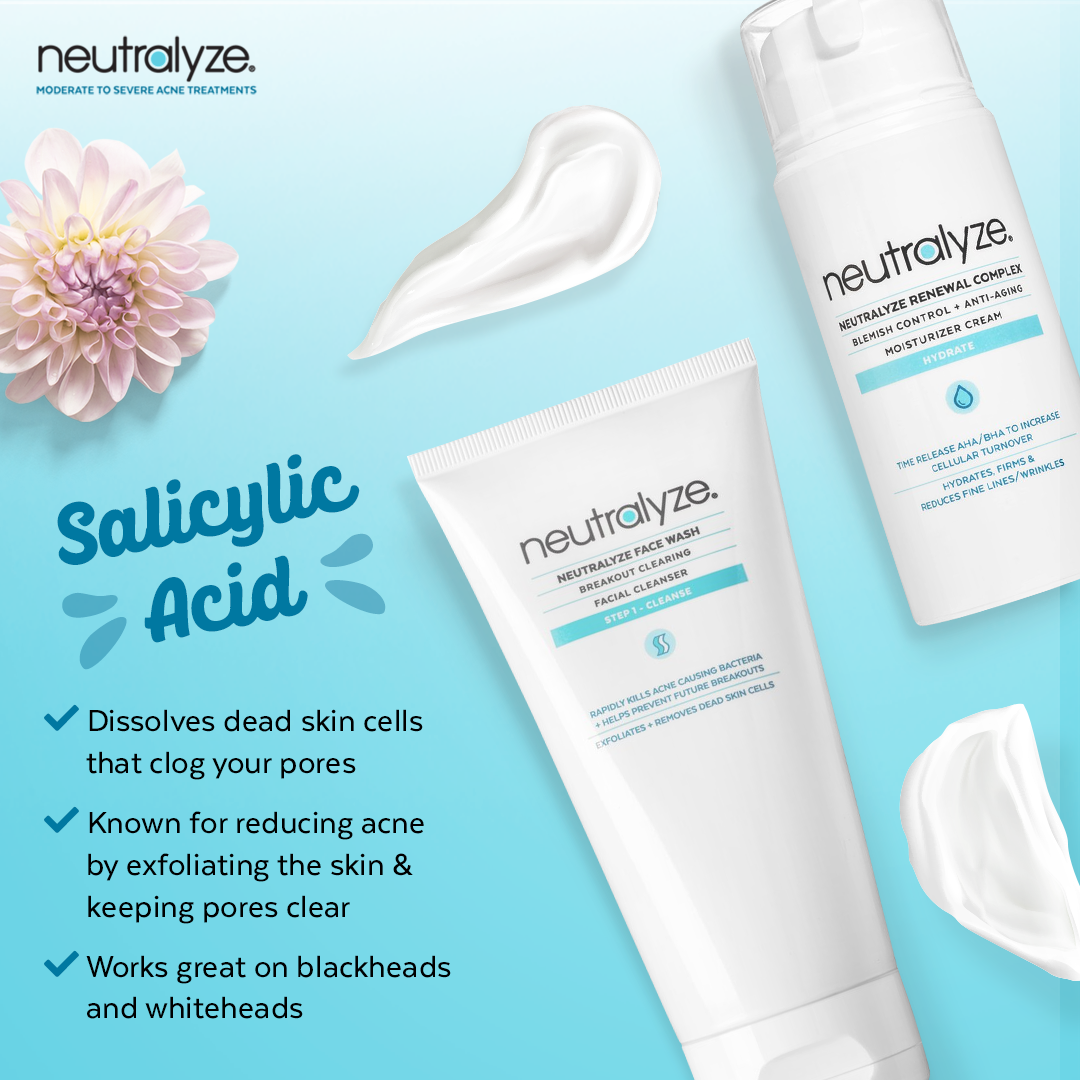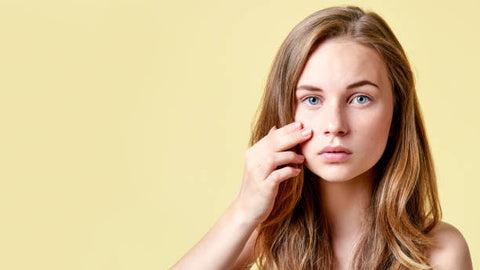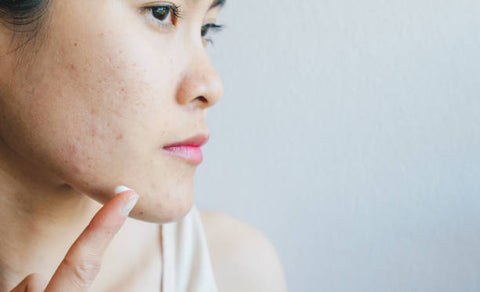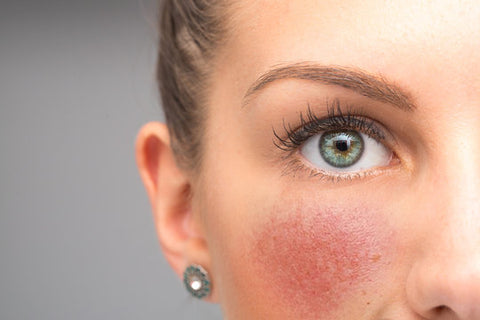6 Best Ingredients for Acne-Prone Skin

What Is Acne-Prone Skin?
Having acne-prone skin means being more susceptible to whiteheads, blackheads, pustules, and nodules than other skin types. Known medically as acne vulgaris, the skin condition constantly changes in severity and may also appear on the other parts of the body aside from the face. Those with acne-prone skin are likely to continue experiencing breakouts until their adulthood.
Types of Acne-Prone Skin
All skin types can become prone to acne. To apply the proper treatment, you need to know whether your acne skin type is non-inflammatory or inflammatory:
Non-inflammatory acne
Also known as comedonal acne, this acne skin type is due to clogged hair follicles. This causes whiteheads and blackheads to form. No skin swelling is involved.
Whiteheads
Whiteheads look like little white or yellowish bumps, which are actually a combination of sebum and dead skin cells that clog the opening of your skin's pores. They're also referred to as closed comedones, as the pore remains closed.
Blackheads
When the trapped oil and dead skin cells bulge and widen your pores, they get exposed to oxygen in the air and turn black, hence the name blackheads. They're also called open comedones because the pore blockage opened up the dermal layer of the skin.
Inflammatory acne
When you have inflamed acne, the breakouts make your skin swell and turn red. Inflammation can be mild, moderate, or severe. The following may erupt within your skin:
-
Papules
-
Pustules
The American Academy of Dermatology Association classifies papules and pustules as pimples.
Nodules
Nodules are deeper lesions that feel like painful lumps under the skin. Swelling occurs in the dermis as debris from a broken follicle wall infects nearby follicles.
Cysts
Cysts are like nodules but contain pus, making them more tender than the former.
6 Best Ingredients Against Acne
While you also need to mind your diet and lifestyle, a treatment plan with these six ingredients can significantly reduce acne:
Salicylic acid
Salicylic acid belongs to salicylates or aspirin, which relieves inflammation and pain. It's also a type of keratolytic agent, meaning it softens the keratin or protein that makes up your skin, hair, and nails. It facilitates exfoliation by breaking down the bonds between dead skin cells that make up skin flakes and scales.
As a type of oil-soluble beta-hydroxy acid (BHA), salicylic acid can unplug pore blockages. It goes deep beneath the skin's surface to flush out the excess sebum from your pores, so it's recommended for those with oily skin. Clear pores give way for other active ingredients to reach the target skin tissues better.
The Mayo Clinic recommends the following percentages according to the type of solution:
- Lotion: 1% to 2%, one to three times a day
- Ointment: 3% to 6%, as needed
- Gel: 0.5% to 5%, once a day
- Pads: one to three times a day
Mandelic Acid
Mandelic acid is another anti-inflammatory acid and a mild exfoliator. It belongs to the family of alpha-hydroxy acids with molecules larger than BHAs, making it a gentler acid. But it has the deepest penetration level among other AHAs (which include lactic and glycolic acid), preventing melanin production.
Mandelic acid is advisable for those with dark skin, as it can diminish hyperpigmentation and dark spots without irritating the skin.
When first using mandelic acid, it’s recommended to start with 5% to 8%.
Bentonite
Bentonite is from volcanic ash. It can come in powder form that you can mix with water to have a clay face mask or cleanser, besides being a cream or lotion ingredient.
Besides absorbing a lot of water, it also adsorbs or attracts particles, including the excess oil and dirt, from your skin.
Bentonite can ease inflammation and minimize pores, as it has a temporary tightening effect on the skin. This is a boon for those who want to reduce skin oiliness.
Also, its calcium, magnesium, iron, sodium, and silica contents help brighten your skin.
Niacinamide
Niacinamide, also referred to as nicotinamide, is a form of vitamin B-3 or niacin. Once applied to the skin, it converts into nicotinamide adenine dinucleotide, which is known for its cellular restorative properties. It promotes the production of ceramides and elastin that make up the skin's protective layer.
Niacinamide also reduces cellular damage due to exposure to ultraviolet rays and environmental pollution and helps balance out the oil production of sebaceous glands.
The ingredient is also popular for lightening the skin, which is helpful for those with discolored skin patches due to acne.
Vitamin C
As an antioxidant, vitamin C fights off cell and tissue-damaging free radicals that trigger inflammation. This same property allows the vitamin to reduce melanin formation and limit UV ray damage.
Additionally, it promotes the production of collagen to hasten the healing of scars caused by breakouts. This also reduces fine lines and wrinkles as collagen firms up the skin.
Bakuchiol
Bakuchiol is derived from the seeds of the Psoralea Corylifolia plant, an herb used in traditional Chinese and Indian medicine.
It's currently labeled as retinol's plant-based alternative, but less harsh and drying. It can reduce enzyme activity in the sebaceous glands, leading to lower sebum production. It can also calm redness, reduce hyperpigmentation, and restore your skin's elasticity.
How to Get the Most from Your Acne Treatment Product
Now that you know the best ingredients to find in an acne treatment solution, here are some tips for optimizing the effects of your chosen product:
Practice proper cleansing
Remember to wash your problem areas twice a day and after sweating using a gentle, non-soap cleanser. Pick a non-abrasive scrub—avoid those with ground fruit pits or exfoliating beads. You can also try cleansing towelettes or cloths with an open weave if you have dry, sensitive skin.
Use your treatments consistently for at least 4 weeks
There's no quick fix—you should give products time to do their work. Apply the solution on your skin daily according to instructions.
Your skin should improve in 4 to 6 weeks and clear in 2 to 3 months if the product works for you. See a dermatologist if nothing happens within that time.
Don't overdo it
Some people tend to over-cleanse or apply more than the amount of anti-acne solution needed due to the belief that acne is a sign of being unhygienic or dirty. You only need to apply enough of the product to cover problem areas after cleansing the skin. Otherwise, you may experience irritation and excessive drying.
Watch what gets in contact with your face
As much as possible, avoid resting your phone or hand against your face. Tie your hair or keep it brushed up. Change your pillowcase every few (one to three) days. The same goes with your headgear, such as hats, bandanas, and headscarves. Also, remember to resist picking and squeezing your acne.
Apply sunscreen
Many acne treatments make your skin more sensitive to UV rays. Use a broad-spectrum, non-comedogenic (oil-free) sunscreen daily. Many of today's moisturizers already have sun protection.
No treatment solution can guarantee a permanent end to acne. But by choosing the right ingredients, you can prevent and control your breakouts.


